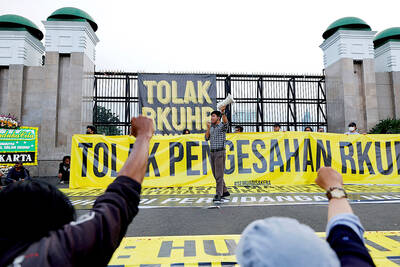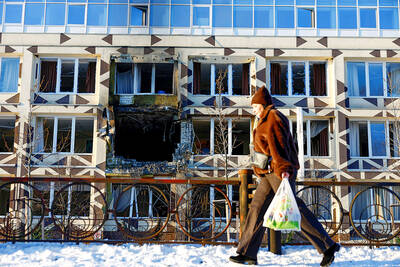Privately-funded Space Exploration Technologies, the company operated by Internet entrepreneur Elon Musk, received final clearance from the US Air Force on Thursday for its debut rocket launch from Florida.
The company known as SpaceX was set to launch its Falcon 9 rocket between 11am and 3pm yesterday from its newly refurbished launch pad at Cape Canaveral Air Force Station, just south of the Kennedy Space Center.
Musk, who moonlights as chairman and chief executive of electric car manufacturer Tesla Motors, put the odds of a successful flight at around 75 percent.
“I think we’re probably three-quarters likely to succeed. I hope that fate favors us tomorrow,” Musk said on a conference call with reporters.
The company has flown smaller rockets from the Kwajalein Atoll’s Omelek Island in the Pacific with mixed success, which Musk says is typical of any new technical system, particularly rocketry. The Falcon 9’s goal is to reach orbit and typically, about half of the first flights of new rockets end short of reaching that mark.
The 55m-high, liquid oxygen and kerosene-fueled booster will carry a mock-up of a SpaceX capsule known as the Dragon, which NASA plans to use to fly cargo — and perhaps astronauts — to the International Space Station (ISS).
NASA is retiring its shuttle fleet after two more flights this year to complete assembly of the ISS, a US$100 billion project of 16 nations. No replacement is planned under the NASA budget proposal for the year beginning Oct. 1, which is pending before US Congress.
While NASA shifts its focus to research and technology development, the Obama administration is looking to private firms like SpaceX to pick up NASA’s share of the ISS resupply business. Russia, Europe and Japan fly cargo ships to the ISS, while Russia operates the only space taxi service for crewmembers. China, which has also flown people in orbit, is not part of the ISS partnership.
Yesterday’s planned flight is part of SpaceX’s US$400 million development effort to design and fly discount rockets for governments, companies and research institutes. Of that, US$100 million came from Musk, co-owner of the PayPal electronic payment system that eBay Inc acquired in 2002 for US$1.5 billion.
SpaceX is selling its Falcon 9 rockets, which can carry 12 tonnes to an orbit about 360km above Earth, for about US$50 million — less than half what is typically charged for rides on similar US rockets.
“If the vehicle lifts off the pad, no matter what the outcome is, we’re going to learn something that’s going to make the second flight more likely and the third flight and the fourth flight,” added Ken Bowersox, a SpaceX vice president and former NASA astronaut.
The firm plans to fly up to three Falcon 9/Dragon test missions for NASA, then begin delivering cargo to the ISS under a US$1.6 billion contract next year. NASA also has a US$1.9 billion ISS resupply contract with Orbital Sciences Corp, which plans to debut its Taurus 2 rocket next year.

Indonesia yesterday began enforcing its newly ratified penal code, replacing a Dutch-era criminal law that had governed the country for more than 80 years and marking a major shift in its legal landscape. Since proclaiming independence in 1945, the Southeast Asian country had continued to operate under a colonial framework widely criticized as outdated and misaligned with Indonesia’s social values. Efforts to revise the code stalled for decades as lawmakers debated how to balance human rights, religious norms and local traditions in the world’s most populous Muslim-majority nation. The 345-page Indonesian Penal Code, known as the KUHP, was passed in 2022. It

‘DISRESPECTFUL’: Katie Miller, the wife of Trump’s most influential adviser, drew ire by posting an image of Greenland in the colors of the US flag, captioning it ‘SOON’ US President Donald Trump on Sunday doubled down on his claim that Greenland should become part of the US, despite calls by the Danish prime minister to stop “threatening” the territory. Washington’s military intervention in Venezuela has reignited fears for Greenland, which Trump has repeatedly said he wants to annex, given its strategic location in the arctic. While aboard Air Force One en route to Washington, Trump reiterated the goal. “We need Greenland from the standpoint of national security, and Denmark is not going to be able to do it,” he said in response to a reporter’s question. “We’ll worry about Greenland in

PERILOUS JOURNEY: Over just a matter of days last month, about 1,600 Afghans who were at risk of perishing due to the cold weather were rescued in the mountains Habibullah set off from his home in western Afghanistan determined to find work in Iran, only for the 15-year-old to freeze to death while walking across the mountainous frontier. “He was forced to go, to bring food for the family,” his mother, Mah Jan, said at her mud home in Ghunjan village. “We have no food to eat, we have no clothes to wear. The house in which I live has no electricity, no water. I have no proper window, nothing to burn for heating,” she added, clutching a photograph of her son. Habibullah was one of at least 18 migrants who died

Russia early yesterday bombarded Ukraine, killing two people in the Kyiv region, authorities said on the eve of a diplomatic summit in France. A nationwide siren was issued just after midnight, while Ukraine’s military said air defenses were operating in several places. In the capital, a private medical facility caught fire as a result of the Russian strikes, killing one person and wounding three others, the State Emergency Service of Kyiv said. It released images of rescuers removing people on stretchers from a gutted building. Another pre-dawn attack on the neighboring city of Fastiv killed one man in his 70s, Kyiv Governor Mykola